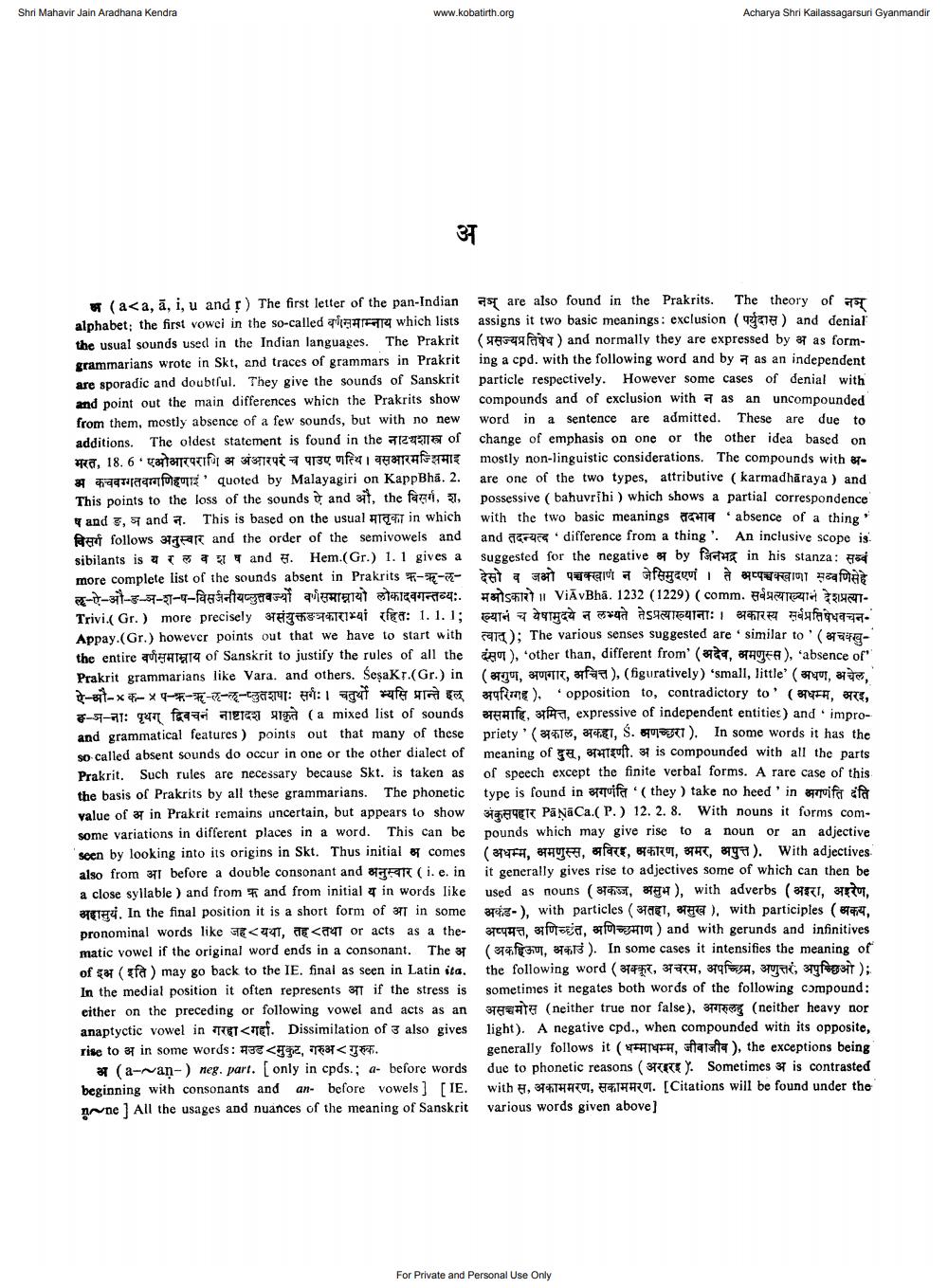________________
Shri Mahavir Jain Aradhana Kendra
www.kobatirth.org
Acharya Shri Kailassagarsuri Gyanmandir
(a<a, ā, i, u and r) The first letter of the pan-Indian Ast are also found in the Prakrits. The theory of ET alphabet: the first vowel in the so-called Tigarrary which lists assigns it two basic meanings: exclusion ( a) and denial the usual sounds used in the Indian languages. The Prakrit (48549 ) and normally they are expressed by a7 as formgrammarians wrote in Skt, and traces of grammars in Prakriting a cpd. with the following word and by 7 as an independent are sporadic and doubtful. They give the sounds of Sanskrit particle respectively. However some cases of denial with and point out the main differences which the Prakrits show compounds and of exclusion with a as an uncompounded from them, mostly absence of a few sounds, but with no new word in a sentence are admitted. These are due to additions. The oldest statement is found in the 12ta of change of emphasis on one or the other idea based on
O, 18. 6. Cartarrarifat 27 3131743 = 34 TA31917 mostly non-linguistic considerations. The compounds with 87# artfugot quoted by Malayagiri on KappBha. 2. are one of the two types, attributive (karmadharaya ) and This points to the loss of the sounds and it, the fagdi, possessive ( bahuvrihi ) which shows a partial correspondence
and 3, 57 and a. This is based on the usual Tee in which with the two basic meanings 19 absence of a thing Per follows 3gar and the order of the semivowels and and a difference from a thing'. An inclusive scope is. sibilants is at
and F. Hem.(Gr.) 1.1 gives a suggested for the negative by ferater in his stanza: more complete list of the sounds absent in Prakrits F- -- H a a falu a afegcui 2909 F ER
-1-1-3-57---faa year41 TERTETAT 1914977784:. 415171 ViāvBha. 1232 (1229) (comm. TTT 1991Trivi. Gr.) more precisely BETTIxi fea1.1.1;
E U
40 as 216919: 1 877 aduanya. Appay.(Gr.) however points out that we have to start with 9 ); The various senses suggested are similar to ' ( cethe entire agura of Sanskrit to justify the rules of all the pt), other than, different from (49. STAVIER), 'absence of Prakrit grammarians like Vara, and others. SeşaKr.(Gr.) in (ago, TuTiT, afaa), (figuratively) 'small, little' ( YU, 7-11-x -- 7- 791: H: gut E 6 3 379fme), opposition to, contradictory to' ( BUFF, .
-अ-नाः पृथग् द्विवचनं नाष्टादश प्राकृते (a mixed list of sounds असमाहि, अमित्त, expressive of independent entities) and • improand grammatical features ) points out that many of these priety' (3751, 37981, S. 81RI). In some words it has the so called absent sounds do occur in one or the other dialect of meaning of ga, vit. 37 is compounded with all the parts Prakrit. Such rules are necessary because Skt. is taken as of speech except the finite verbal forms. A rare case of this the basis of Prakrits by all these grammarians. The phonetic type is found in fruitc ( they ) take no heed' in riffa value of 7 in Prakrit remains uncertain, but appears to show 3189€ Pa ŅaCa.(P.) 12.2. 8. With nouns it forms comsome variations in different places in a word. This can be pounds which may give rise to a noun or an adjective seen by looking into its origins in Skt. Thus initial e comes (37477, HUF, force, 54170T, 8H, Byu ). With adjectives also from 3 before a double consonant and 855T (i. e. in it generally gives rise to adjectives some of which can then be a close syllable ) and from F and from initial in words like used as nouns (879157, 384 ), with adverbs (375CI, 31201 अहासुयं. In the final position it is a short form of आ in some अकंड-), with particles (अतहा, असुख ), with participles (अकय, pronominal words like <TT, TE <a4T or acts as a the- 30447, fotorja, 2011 ) and with gerunds and infinitives matic vowel if the original word ends in a consonant. The 37 (37SU, 379.13 ). In some cases it intensifies the meaning of of famay go back to the IE. final as seen in Latin ita. the following word (374K, 370CH, 399FH, STUTTIC, Tyfogsit); In the medial position it often represents 3T if the stress is sometimes it negates both words of the following compound: either on the preceding or following vowel and acts as an STEFATE (neither true nor false), S (neither heavy nor anaptyctic vowel in TOET<tef. Dissimilation of 3 also gives light). A negative cpd., when compounded with its opposite, rise to 3 in some words: #33 < 3, TE3T<.
generally follows it (धम्माधम्म, जीवाजीव), the exceptions being (a-van-) neg. part. only in cpds.; a- before words due to phonetic reasons (UKE). Sometimes 37 is contrasted beginning with consonants and an- before vowels ] [IE. with , THATUT, 1 T. [Citations will be found under the n ne ] All the usages and nuances of the meaning of Sanskrit various words given above]
For Private and Personal Use Only




